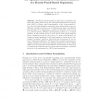Free Online Productivity Tools
i2Speak
i2Symbol
i2OCR
iTex2Img
iWeb2Print
iWeb2Shot
i2Type
iPdf2Split
iPdf2Merge
i2Bopomofo
i2Arabic
i2Style
i2Image
i2PDF
iLatex2Rtf
Sci2ools
110
Voted
IDA
2009
Springer
2009
Springer
On Optimal Selection of Correlation Matrices for Matrix-Pencil-Based Separation
Abstract. The Matrix-Pencil approach to blind source separation estimates the mixing matrix from the Generalized Eigenvalue Decomposition (GEVD), or Exact Joint Diagonalization, of two “target-matrices”. In a Second-Order-Statistics framework, these target-matrices are two different correlation matrices (e.g., at different lags, taken over different time-intervals, etc.), attempting to capture the diversity of the sources (e.g., diverse spectra, different nonstationarity profiles, etc.). A central question in this context is how to best choose these target-matrices, given a statistical model for the sources. To answer this question, we consider a general paradigm for the target-matrices, viewed as two “generalized correlation” matrices, whose structure is governed by two selected “Association-Matrices”. We then derive an explicit expression (assuming Gaussian sources) for the resulting Interference-to-Source Ratio (ISR) in terms of the Association-Matrices. Subsequentl...
Artificial Intelligence | Blind Source Separation | Different Correlation Matrices | Exact Joint Diagonalization | IDA 2009 |
Related Content
| Added | 26 May 2010 |
| Updated | 26 May 2010 |
| Type | Conference |
| Year | 2009 |
| Where | IDA |
| Authors | Arie Yeredor |
Comments (0)

